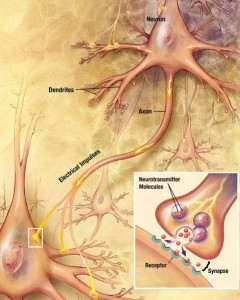
Many laboratory studies suggest that exercise stimulates nerve growth factors and stem cells. Brain function is improved by an increased interconnection between cells known as neurons, which use electrical and chemical signals to process and transmit information. There is even evidence that seems to indicate resistance training with weights and aerobic activities like running may affect different parts of the brain.
Cardiovascular exercise combined with activities that require coordination or strategizing, such as dance classes or circuit training with high intensity aerobics, can maximize the benefits to your brain. Exercise that requires us to apply accuracy and precision in movement will promote motor learning with a resultant increase in cross-links between brain cells. The ancient Chinese practice of improving balance and coordination with “retro walking”, walking backwards, has been advocated to improve cognition through the additional demands it places on the brain with different patterns of muscle activation. With a little practice, you can do this safely on a StairMaster or treadmill as part of your efforts to remain vibrant and youthful well into old age.
Tags: anti-aging, exercise
Written by Dr. Forley on September 22, 2013




